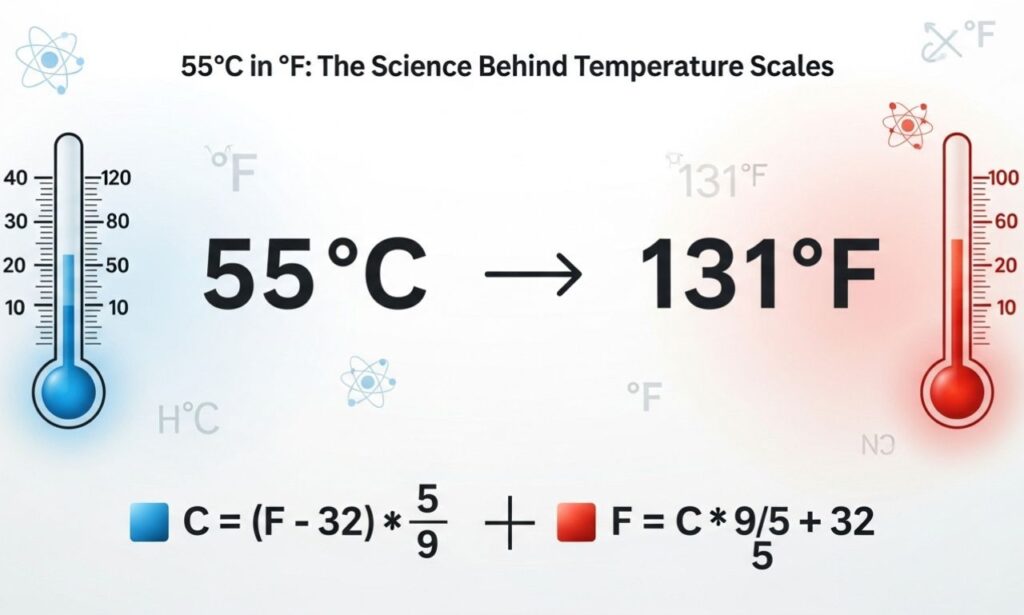Temperature is a fundamental aspect of our daily lives, influencing everything from the weather to cooking and even how we feel. But have you ever stopped to think about how temperature is measured? The world uses various scales that can seem confusing at times, especially when converting between them. One common question that arises is: what is 55c in f in Fahrenheit?
Whether you’re planning a trip abroad or just curious about the science behind these measurements, understanding temperature scales can enhance your knowledge and experience. Let’s dive into the fascinating world of Celsius, Fahrenheit, and Kelvin while exploring their practical applications and historical background!
What is 55c in f?
To convert 55c in f degrees Celsius to Fahrenheit, you can use a simple formula. Multiply the Celsius temperature by 9/5 and then add 32.
For our case:
55°C multiplied by 9/5 equals 99°F.
Then add the base value of 32.
So, when you do the math, you’ll find that 55°C is equivalent to about 131°F.
This conversion is crucial for many fields, especially in cooking or weather reporting. Different regions use different scales, making it essential to understand how they relate.
Knowing what temperatures mean across scales helps avoid confusion in everyday life. Whether you’re adjusting a recipe or checking the forecast, converting temperatures accurately matters greatly!
Celsius Scale
The Celsius scale, also known as centigrade, is a temperature measurement system widely used around the globe. It’s based on the freezing and boiling points of water—55c in f marks the former while 100°C denotes the latter.
This straightforward approach makes Celsius intuitive for everyday use. It’s particularly popular in scientific contexts, where precision matters.
And did you know that this scale was named after Swedish astronomer Anders Celsius? He introduced it in 1742, proposing a simple way to measure temperature based on water’s unique properties.
Celsius aligns with metric units, making conversions easier when dealing with other measurements like mass or length. As global temperatures rise due to climate change, understanding this scale becomes even more crucial for interpreting weather reports and scientific data accurately.
Fahrenheit Scale
The Fahrenheit scale, developed by Daniel Gabriel Fahrenheit in the early 18th century, is a temperature measurement system primarily used in the United States. It assigns 32 degrees as the freezing point of water and 212 degrees as its boiling point at standard atmospheric pressure.
What sets Fahrenheit apart is its unique approach to defining temperatures based on human experience. For instance, body temperature is approximately 98.6°F. This makes it easier for many people to relate to everyday weather conditions.
One fascinating aspect of this scale is its degree intervals. Each degree represents a smaller change compared to Celsius, which can lead to more precise measurements in certain contexts.
Despite being less common globally than Celsius or Kelvin, the Fahrenheit scale remains deeply rooted in American culture and daily life. Weather forecasts and home thermometers often rely on this familiar format that has stood the test of time.
Kelvin Scale
The Kelvin scale is a fundamental temperature measurement used primarily in scientific contexts. Unlike Celsius and Fahrenheit, it starts at absolute zero, the point where molecular motion ceases.
Zero Kelvin (0 K) is equivalent to -273.15 degrees Celsius. This makes it an ideal reference for thermodynamic calculations. Scientists often prefer Kelvin when discussing physical properties because it provides a direct correlation to energy levels.
One unique aspect of the Kelvin scale is that its increments are identical to those in the Celsius scale. This means a change of 1 K equals a change of 1 °C, making conversions straightforward.
Although not commonly used in everyday life, the Kelvin scale plays a crucial role in fields like physics and engineering. Whether it’s studying black-body radiation or measuring temperatures in space, this scale remains indispensable for precise scientific work.
Comparison of Scales and their Units
When comparing temperature scales, it’s essential to understand how each one operates. The Celsius scale is based on the freezing and boiling points of water: 0°C and 100°C respectively. It provides a straightforward way for scientists and everyday people to reference temperatures in relation to this common substance.
On the other hand, the Fahrenheit scale divides its range differently. Water freezes at 32°F and boils at 212°F, creating a wider spread that can be confusing without context. This system is primarily used in the United States for daily weather forecasts.
The Kelvin scale introduces an absolute perspective by starting at absolute zero – the theoretical lowest possible temperature where molecular motion stops. Here, water freezes at approximately 273.15K and boils at about 373.15K.
Each scale serves distinct purposes depending on cultural use or scientific requirements, making them vital tools across various fields.
History and Development of Temperature Scales
The journey of temperature scales is quite fascinating. It began in the early 18th century with Daniel Gabriel Fahrenheit, who introduced his scale in 1724. He used the freezing point of brine and human body temperature as reference points.
Around the same time, Anders Celsius developed his scale in 1742. The original Celsius scale set zero at boiling water and one hundred at freezing; however, it was later inverted to its current form.
Then came Lord Kelvin in the mid-19th century, who created an absolute temperature scale based on thermodynamic principles. His work laid a foundation for scientific applications.
Each of these innovations addressed specific needs—whether for weather forecasting or laboratory measurements. Over time, they gained popularity and became standardized across various fields worldwide. As science progressed, so did our understanding of heat and cold—shaping how we measure them today.
Practical Applications of Temperature Scales
Temperature scales play a crucial role in everyday life, guiding various industries and personal activities. In cooking, precise temperature measurements ensure that food is prepared safely and to perfection. Recipes often specify Celsius or Fahrenheit depending on the region, demonstrating how these scales influence culinary practices.
In science and engineering, accurate temperature readings are vital for experiments and product development. Thermodynamics relies heavily on these scales to understand energy transfers.
Meteorology also depends on temperature conversions to communicate weather patterns effectively. Whether it’s predicting a heatwave or analyzing climate data, knowing both Celsius and Fahrenheit helps in conveying critical information.
Health care professionals utilize temperature measurements to monitor patient conditions. A slight change can indicate illness or recovery.
From home thermostats to industrial applications, the importance of understanding different temperature scales cannot be overstated; they enhance safety and efficiency across multiple fields.
Debunking Common Myths about the Celsius vs Fahrenheit Debate
Many people believe that Celsius is superior because it’s based on water’s properties. While it’s true that the freezing and boiling points of water are integral to the scale, this doesn’t make one system better than another.
Another myth suggests Fahrenheit is only used in the U.
55c in f. In reality, several Caribbean nations still embrace Fahrenheit for temperature reporting.
Some argue Celsius is easier for scientific purposes due to its simplicity. However, many scientists conveniently use Kelvin when needed since it’s based on absolute zero.
Those who think one scale should dominate often ignore regional preferences and cultural significance tied to these systems. Each scale serves different communities effectively.
Understanding both perspectives enriches our grasp of temperature measurement rather than fueling unnecessary debate about which is right or wrong.
Conclusion
Understanding temperature scales enriches our grasp of the world around us. Temperature measurement is crucial in numerous fields, from science and engineering to everyday life.
When we talk about 55c in f degrees Celsius, knowing its Fahrenheit equivalent (which is 131 degrees Fahrenheit) helps bridge gaps in communication, especially with varying regional standards.
The Celsius scale is widely used for scientific purposes, while the Fahrenheit scale remains popular in specific countries like the United States. The Kelvin scale serves as a fundamental measure in thermodynamics and absolute temperature measurement.
Each of these scales has its own history and development that reflects society’s evolving needs. With practical applications ranging from cooking to weather forecasting, understanding how they interrelate can enhance daily experiences.
Myths often cloud discussions about these scales—debunking them reveals a more informed perspective on their uses and significance.
Temperature isn’t just numbers; it’s an integral part of our lives that deserves appreciation within its scientific framework.






